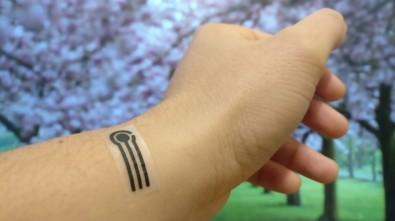Wearable sensors printed on natural materials analyze substances present in sweat

Applied to skin as a piece of sticking plaster, the device developed by Brazilian researchers can be used to monitor human metabolism and administer drugs.
Credit: Robson Rosa da Silva
Applied to skin as a piece of sticking plaster, the device developed by Brazilian researchers can be used to monitor human metabolism and administer drugs
A wearable sensor printed on microbial nanocellulose, a natural polymer, has been created in Brazil by researchers at the University of São Paulo (USP) in São Carlos in collaboration with colleagues at São Paulo State University (UNESP) in Araraquara, the University of Araraquara (UNIARA), the University of Campinas (UNICAMP), and the Brazilian National Nanotechnology Laboratory (LNNano).
The skin-adherent sensor is an improved substitute for conventional sensors printed on plastic surfaces. It can be used for noninvasive detection and monitoring of body fluids present in sweat.
The study was led by Osvaldo Novais de Oliveira Junior and supported by FAPESP via the projects “Printed and implantable biosensors made from biopolymers for long-term monitoring”, “Design and fabrication of nanostructured flexible devices for biomarker detection” and “Development of analytical tools based on electronic tongues for simultaneous detection of bacterial threats”, as well as a Multiuser Equipment grant.
The article titled “Microbial nanocellulose adherent to human skin used in electrochemical sensors to detect metal ions and biomarkers in sweat” is published in the journal Talanta.
“Microbial nanocellulose is a 100% natural polymer. It is produced by bacteria from sugar. Its main advantage over plastic is its far better interface with human skin. It’s been commercially available for some years for use in wound dressings, among other applications, but it had never before been studied as an electrochemical sensor substrate,” said Robson Rosa da Silva, a co-first author of the article.
One of the problems with wearable sensors on plastic substrates is that perspiration forms a barrier between the skin and sensor, hindering detection and promoting allergies. “Nanocellulose is totally breathable, enabling sweat to reach the electrode’s active layer,” Silva said.
The sensor is a small adhesive rectangle 1.5 cm in length by 0.5 cm in width and is as thin as a sheet of tissue paper. It can detect a range of biomarkers, such as sodium, potassium, uric acid, lactic acid and glucose, among others. “These elements or substances circulate in the bloodstream and are also detectable in sweat. Therefore, diabetes monitoring is one possible application of the nanocellulose sensor. Another is hormone control in women via detection of the hormone estradiol,” Silva said.
The device can also be used to detect the presence of atmospheric pollutants in organisms. “As proof of concept, we exposed the sensor to low levels of toxic metals such as lead and cadmium, and the result was positive,” he said.
The detection units are printed on the microbial nanocellulose substrate using a semiautomatic screen printer and a paste with a high concentration of carbon particles. Carbon is preferred owing to its significant electrical conductivity. “Chemical oxidation-reduction reactions produce an electrical signal that measures the concentration of the metabolite of interest,” explained Paulo Augusto Raymundo Pereira, the other co-first author of the article.
“The sensor is connected to a potentiostat that makes electrochemical measurements by means of variations in the electric current. The data obtained are transmitted to a computer and converted into standard curves.”
According to Pereira, wireless communication between the sensor and a data measuring and reading device can easily be engineered.
The researchers are now studying the use of the sensor to administer drugs and are working on ways of making it commercially feasible. The first phase of the project “Fabrication of screen printed electrodes on biodegradable substrates (nanocellulose and onion films Allium cepa L.) for medical, food and agroindustrial applications”, conducted by Biosmart Nanotechnology, was supported by FAPESP’s Innovative Research in Small Business (PIPE) Program.
###
About São Paulo Research Foundation (FAPESP)
The São Paulo Research Foundation (FAPESP) is a public institution with the mission of supporting scientific research in all fields of knowledge by awarding scholarships, fellowships and grants to investigators linked with higher education and research institutions in the State of São Paulo, Brazil. FAPESP is aware that the very best research can only be done by working with the best researchers internationally. Therefore, it has established partnerships with funding agencies, higher education, private companies, and research organizations in other countries known for the quality of their research and has been encouraging scientists funded by its grants to further develop their international collaboration. You can learn more about FAPESP at http://www.
All latest news from the category: Materials Sciences
Materials management deals with the research, development, manufacturing and processing of raw and industrial materials. Key aspects here are biological and medical issues, which play an increasingly important role in this field.
innovations-report offers in-depth articles related to the development and application of materials and the structure and properties of new materials.
Newest articles

Innovative 3D printed scaffolds offer new hope for bone healing
Researchers at the Institute for Bioengineering of Catalonia have developed novel 3D printed PLA-CaP scaffolds that promote blood vessel formation, ensuring better healing and regeneration of bone tissue. Bone is…

The surprising role of gut infection in Alzheimer’s disease
ASU- and Banner Alzheimer’s Institute-led study implicates link between a common virus and the disease, which travels from the gut to the brain and may be a target for antiviral…

Molecular gardening: New enzymes discovered for protein modification pruning
How deubiquitinases USP53 and USP54 cleave long polyubiquitin chains and how the former is linked to liver disease in children. Deubiquitinases (DUBs) are enzymes used by cells to trim protein…



